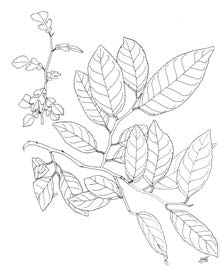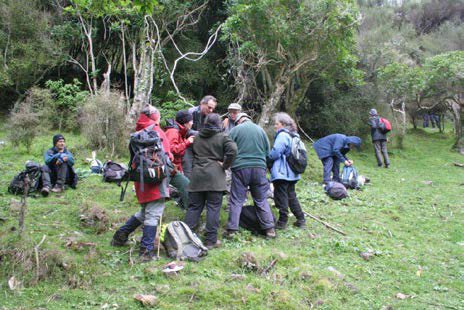Trip Report – 1 August 2015 : Taparanga Block, Baring Head
On a cool, blustery morning, with showers forecast, twenty-two intrepid BotSoccers met at the Baring Head car-park. Before starting our botanical exploration, Robyn Smith, GWRC’s Biodiversity Advisor, explained the GWRC Biodiversity Department’s plans for the site, part of the Baring Head Key Native Ecosystem management area. This was the first botanical survey on the property, so a species list will be of value to GWRC, and to the landowners who will receive a copy.
After a health and safety briefing we crossed the bridge and walked along the farm road up the true right of the Wainuiomata River to the East Harbour Regional Park boundary. Once through the gate, our pace slowed as we began listing species. The vegetation at the start, along the track upstream of the boundary, was mainly exotic rough pasture species. On the slope above were native shrubs, gorse and some small native herbs and monocots. Common native species found here were
Carmichaelia australis,
Coprosma propinqua subsp.
propinqua,
Lagenophora sp,
Clematis forsteri,
Pyrrosia eleagnifolia and
Melicytus crassifolius. East of the farm track, old river and creek channels contain native wetland species, e.g.,
Isolepis prolifer, but they were dominated by the exotic weeds,
Glyceria declinata / floating sweet grass, and
Aponogeton distachyus / Cape pondweed, and a small area of
Myriophyllum aquaticum / parrot’s feather.
 |
Streblus banksii – juvenile foliage top left. Illustration: Eleanor Burton.
|
We came to the first gully and some exciting finds, e.g., several large
Agave americana / century plant, and a concrete pad nearby, possibly an old homestead, at the entrance to a small gully. A little way up it, a large, old
Myoporum laetum / ngaio, marked a bend in the gully to the south and back towards the park. Just up the gully we found a mature
Melicope ternata x
M. simplex. At this stage excitement levels rose and people started to explore more widely with the understanding that we all meet for first lunch at 11 a.m. near the large kaihikatea tree in the next gully to the north. Dominant species in the first gully were
Leptospermum scoparium agg. and
Kunzea robusta, with an understorey of ferns, rushes and sedges; species such as
Blechnum membranaceum,
B. chambersii,
B. minus,
Polystichum oculatum,
P. neozelandicum subsp.
zerophyllum,
P. vestitum.
Cyperus ustulatus,
Juncus spp., and a good population of rasp fern /
Blechnum parrisiae (
Doodia australis).
The farm track then sidled up and over a small spur which formed a raised flat terrace where the track crossed it. The spur was dominated by exotic grasses with a canopy of kanuka and manuka in places. After looking at the different forms of the kanuka, we discussed if what we were seeing was all
K. robusta, or was another
Kunzea also present. We then descended to the second gully, and the most exciting finds of the day. Robyn was excited to find a wet area (seep) in the bottom of the gully with
Juncus pallidus,
J. sarophorus and
Carex secta. A large, mature, kaihikatea, with numerous epiphytes, guards the valley entrance. However it was the plants in the vicinity that provided a flurry of activity and interest as we spread to the four winds and soon found more of Tane’s taonga. The exciting finds before first lunch were a large-leaved milk tree /
Streblus banksii covered in native lianes, and a small-leaved milk tree /
S. heterophyllus, also a stand of
Melicope simplex,
Podocarpus totara,
Brachyglottis lagopus, more
Polystichum oculatum, and
P. neozelandicum subsp.
zerophyllum, and more
Blechnum parrisiae. At 11 a.m. people re-emerged for first lunch to discuss their finds, comment on the amount of the weedy
Selaginella kraussiana, consider the grazing of wetlands, and decide where to head next.
After lunch, we agreed to meet near a large
Cordyline australis further up the gully at 2 p.m. for second lunch. The fitter and keener bods headed up the second gully and onto the ridges either side where they found a remnant of black beech forest, and a suite of species associated with this habitat. The ridges on either side were dominated by a canopy of kanuka and manuka, with an understorey with
Uncinia,
Adiantum,
Asplenium,
Blechnum and
Polystichum species; and the orchids
Acianthus sinclarii and
Pterostylis alobula. Above here, gorse was more dominant in the canopy. Those wanting to cover less ground searched up the valley a short distance, and the lower true left side of the gully where the dominant canopy species were
Cyathea,
Pseudopanax,
Knightia and
Melicytus. The taonga found were lone plants of
Fuchsia perscandens,
Coprosma rubra and
Nestegis lanceolata. There were some obvious animal trails in this area, and a lack of regeneration under the tree ferns. At second lunch in light drizzle, we discussed which species of ferns and
Nestegis were present.
 |
Which Nestegis is it?
|
After lunch some headed back, and others went back down the gully to the edge of the river flats where we found meandering water channels filled with
Isolepis prolifer and some
Carex spp. The sides of the slopes along the river flats above the second gully were almost solid gorse, interspersed with native divaricates. As the rain and wind slowly strengthened, we returned to the car-park. Thank you to all for coming, the great company, and making the day such a success. The area we searched proved to be botanically highly diverse, with the surprises being the old forest remnants and several locally rare species. See you all in March when Robyn will lead another trip to the same property.
Participants: Michael Bartlett, Eleanor Burton, Gavin Dench, Ian and Jill Goodwin, Richard Grasse, Bryan Halliday, Chris Hopkins, Chris Horne, Jane Humble, Pascale Michel, Barbara Mitcalfe, Chris Moore, Syd Moore, Mick Parsons, Leon Perrie, Lara Shepherd, Sunita Singh, Robyn Smith (co-leader), Owen Spearpoint (co-leader / scribe), Julia Stace, Julia White.

 Site Index
Site Index







 Site Index
Site Index





